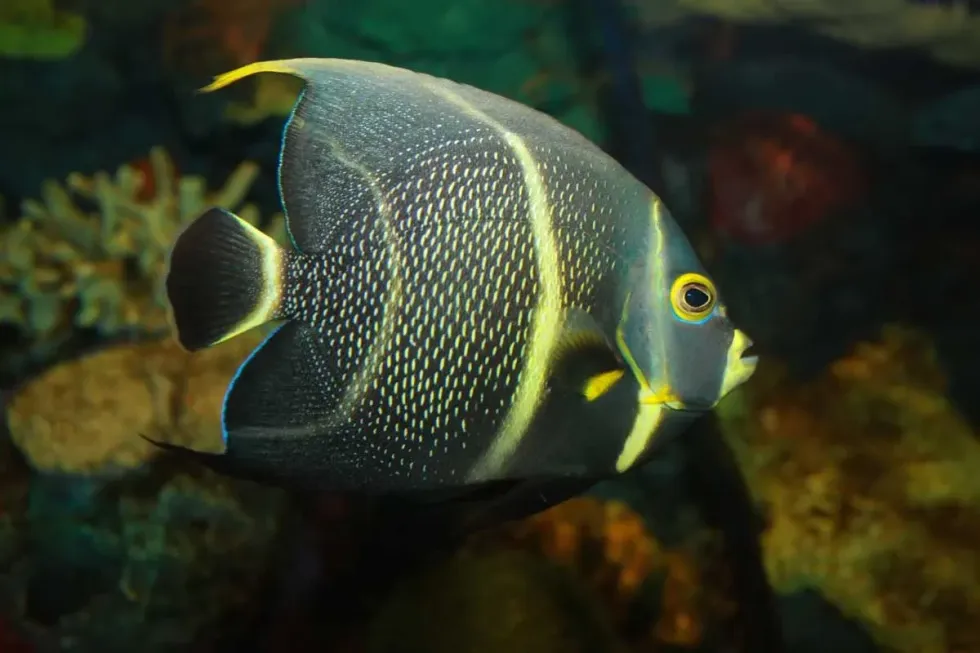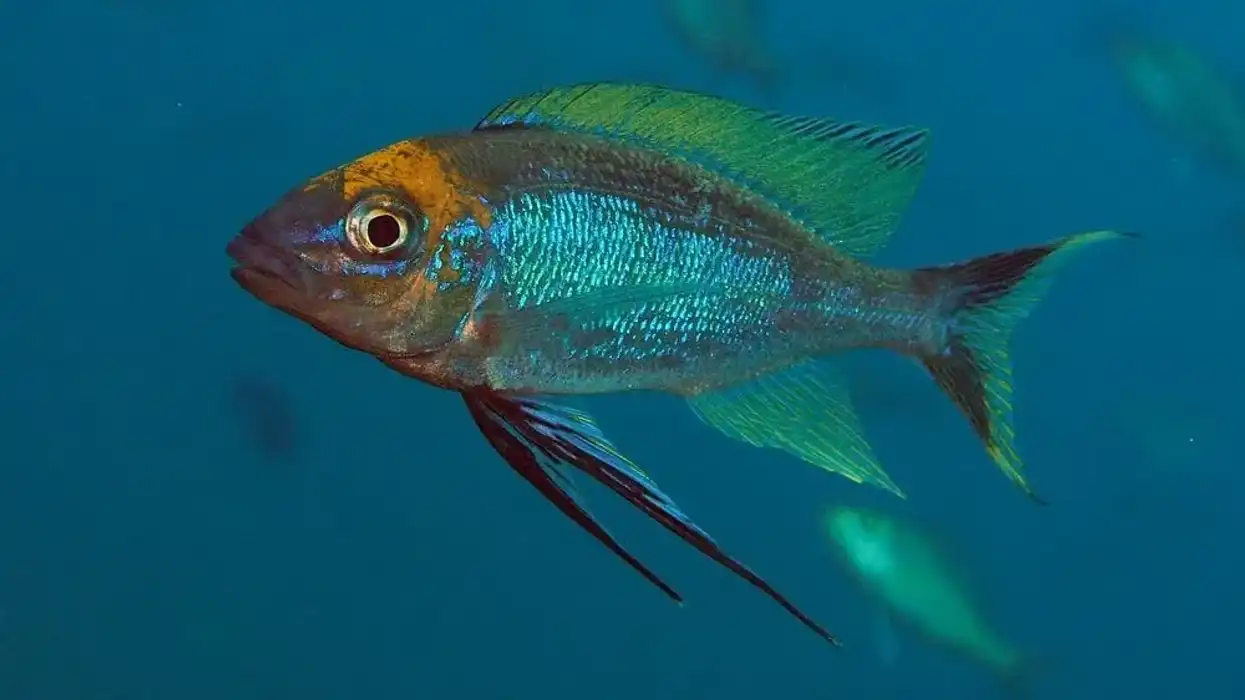Pomacanthus paru (French angelfish) is a member of the order Perciformes. This fish can be found in various parts of the world including the eastern and western Atlantic Ocean, the Indian Ocean, the Amazon Basin, and the western Pacific Ocean where they are found quite abundantly.
Their black scales with bright yellow rims give them quite a unique and vibrant appearance.
Adult French angelfish mainly feed on sponges, algae, and some invertebrates. This species of fish is always seen in pairs. These pairs forage and take shelter together.
Juveniles are known to perform the job of cleaning ectoparasites off other fish. French angelfish make very popular pets as well.
Often, adult and juvenile French angelfish differ in appearance. In Singapore and Thailand, this fish is a local delicacy however, unfortunately, it is known to cause ciguatera poisoning in humans. French angelfish are territorial in nature and they also display curious behavior by swimming towards divers and snorkelers.
To know more about the French angelfish, read the article below! You can also check out tarpon and beluga sturgeon.
French Angelfish Interesting Facts
What type of animal is a French angelfish?
French angelfish is a kind of fish found in the Atlantic Ocean, the Indian Ocean, the Amazon Basin, and the western Pacific Ocean. They are a part of the genus Pomacanthus which has several other species.
What class of animal does a French angelfish belong to?
French angelfish belong to the class Actinopterygii. They are a member of the order Perciformes and family Pomacanthidae.
How many French angelfish are there in the world?
The exact number of individuals present in this species is not known. However, their population has been assessed to be stable by the International Union for Conservation of Nature or IUCN. French angelfish are found quite commonly in their habitats and range.
Where does a French angelfish live?
French angelfish are found in both the eastern and western Atlantic Ocean. In the eastern region, these species are found off St. Paul's Rocks and Ascension Island. Along the western region, they are seen from Florida to Brazil.
French angelfish can also be found in various freshwater regions in South America, the western Pacific Ocean, and the Indian Ocean. They have also been sighted on the Gulf of Mexico and the Caribbean Sea. Rare sightings of this species have been made off the coast of New York as well.
What is a French angelfish habitat?
The habitat of a French angelfish (Pomacanthus paru) mainly includes coral reefs. This fish lives around 15 ft (457 cm) below the water surface and they are known to be territorial in nature. The reef provides a French angelfish enough space to hide from potential predators. French angelfish are also known to return to the same reef every night.
Who do French angelfish live with?
French angelfish are known to form pairs to live. Such mates remain together throughout their lives and swim around the ocean and sea together.
How long does a French angelfish live?
A French angelfish (Pomacanthus paru) can live as long as 10 years.
How do they reproduce?
The spawning season for French angelfish occurs from April through September. Male and female adult French angelfish swim towards the water surface in order to spawn.
Once they reach a preferable height, male and female fish release their sperms and eggs, respectively. Following this, external fertilization takes place. Females are known to lay between 25,000 to 75,000 eggs.
The eggs hatch 1 to 20 hours after fertilization and the larvae come out which live among the plankton. Once the larvae attain proper length, they swim downwards to live in the reef.
What is their conservation status?
The conservation status of the Pomacanthus paru has been marked as Least Concern in the Red List of the International Union for Conservation of Nature. However, over-harvesting is a threat to this species.
French Angelfish Fun Facts
What do French angelfish look like?
French angelfish appear very bright and ornamental. Their scales are black and have golden yellow rims. There are yellow bars at the end of their pectoral fins. They also have yellow bands which extend down their foreheads.
Juvenile French angelfish have a different kind of appearance. Their bodies are dark brown or black and have three vertical yellow bands. These vertical yellow bands continue to the fins. Just like other angelfish, French angelfish also have comb-like teeth in their small mouth.
How cute are they?
A Pomacanthus paru fish can be described as being quite bright and unique due to the yellow bars on its body. They are also special due to the cleaning activities they perform in the ocean.
How do they communicate?
This fish is known to communicate and perceive through tactile and chemical methods. French angelfish pairs also perform short chases before spawning.
How big is a French angelfish?
The most common body length of this fish is 16 in (40.64 cm). However, some may grow as long as 24 in (61 cm). French angelfish reach sexual maturity when they are 10 in (25 cm) long.
How fast can a French angelfish swim?
Though the exact swimming speed of French angelfish is not known, this species of fish are quite quick swimmers due to their long tail fins which allow them to make fast turns. They also use their pectoral fins to swim in the water. The body size of this angelfish lets it swim into narrow cracks in the coral reefs.
How much does a French angelfish weigh?
The weight of a Pomacanthus paru (French angelfish) is not known. However, most members in this family have a weight in the range of 2 lb (0.9 kg).
What are their male and female names of the species?
Adult males and females of this species are known as male French angelfish and female French angelfish.
What would you call a baby French angelfish?
A baby French angelfish is known as a 'larva' or 'juvenile French angelfish'.
What do they eat?
A French angelfish (Pomacanthus paru) has an omnivorous diet. Their diet mostly consists of sponges, algae, coral, and tunicates. Juveniles also eat detritus and parasites which are present in other fish and they also consume invertebrates as part of their diet.
Are they dangerous?
French angelfish are not really dangerous for humans. However, this fish can cause ciguatera poisoning when consumed by humans.
Would they make a good pet?
French angelfish are one of the most commonly kept species of fish as pets. Due to their bright, ornamental black and yellow body, they are quite a popular pet fish.
This fish is best kept in larger tanks as they can get aggressive towards other fish in a smaller space. If adequate care is provided, a pet French angelfish can survive for years.
Did you know...
This fish was originally described as Chaetodon paru in 1787 by Marcus Bloch, who was a German ichthyologist.
In Portuguese, this fish is known as 'Paru'.
French angelfish and gray angelfish are considered to be 'sibling species'.
What unique job does a French angelfish do?
French angelfish are known to set up cleaning stations in their natural habitat to clean ectoparasites off different kinds of fish. Mostly juveniles are seen in such stations and can be seen swimming in a fluttering motion in their cleaning stations.
While cleaning, they touch the body of their 'clients' with their pelvic fins. Some of the common fish the juveniles tend to are snappers, morays, surgeonfishes, and jacks.
What is the largest angelfish?
A gray angelfish (Pomacanthus arcuatus) is the largest angelfish. The length of the body of this fish is 24 in (61 cm). They have a weight of 4 lb (1.8 kg).
Here at Kidadl, we have carefully created lots of interesting family-friendly animal facts for everyone to discover! Learn more about some other fishes including walleye fish or blowfish.
You can even occupy yourself at home by drawing one on our French angel fish coloring pages.









